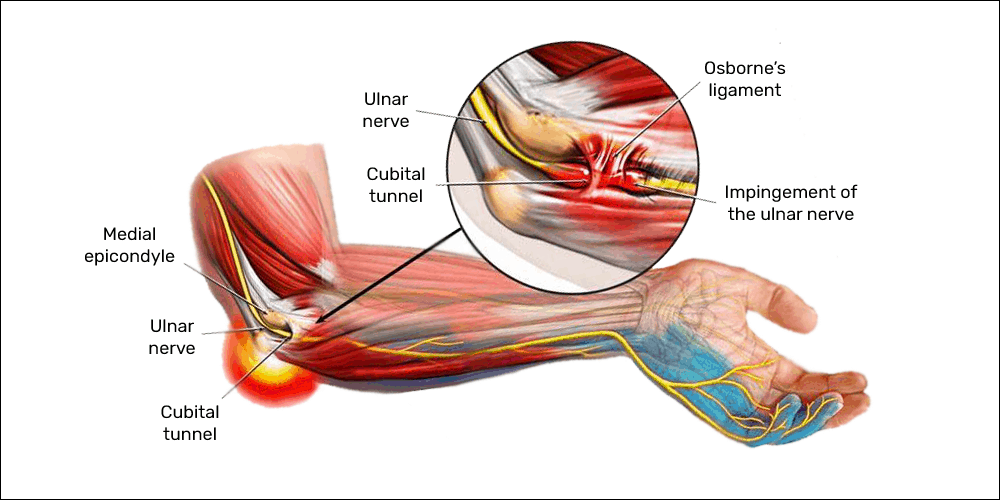- Conditions
- Procedures
- Patient care
- Why choose us
- Our Doctors
- Contact
Ulnar Nerve Entrapment (Cubital Tunnel Syndrome)

A guide to ulnar nerve entrapment and cubital tunnel syndrome
Cubital tunnel syndrome describes a painful condition that can affect the elbows, arms and hands by causing nerve compression. Also known as ulnar nerve entrapment at the elbow, cubital tunnel syndrome can have a number of causes, including overuse or putting excess pressure on the elbow. Cubital tunnel syndrome can benefit from proactive treatment and an early diagnosis.
For people whose work, hobbies and daily activities are affected by cubital tunnel syndrome and ulnar nerve entrapment, there are effective treatments to help manage symptoms. Take a moment to read this brief and informative guide. If you have any questions or want to learn more about treatments, don’t hesitate to reach out to our team.
What causes cubital tunnel syndrome and ulnar nerve entrapment at the elbow?
The elbow is a critical joint that allows for almost all basic arm movements. However, there are also a number of nerves that must pass through this narrow passageway. When this condition begins to develop, a narrow tunnel of tissue, called the cubital tunnel, becomes compressed. This can negatively affect the nerves that pass through it, including the ulnar nerve, which provides sensation and movement to the little finger and part of the ring finger. Entrapment of the ulnar nerve at the cubital tunnel is relatively common because there is little soft tissue to protect it, and bending movements along with pressure on the elbow can cause severe constriction.
Specific causes that can lead to cubital tunnel syndrome developing in patients include:
- Activities that involve repetitive bending of the elbow or keeping it bent for long periods of time
- Elbow posture issues that put excessive pressure on the nerve, including sleeping positions
- Fluid buildup in the elbow that puts pressure on the ulnar nerve
- Joint inflammation due to arthritis or other inflammatory conditions
Practicing a healthy lifestyle that includes taking regular breaks from repetitive motions and using proper arm posture are recommended ways to decrease the risk of developing cubital tunnel syndrome.
Cubital tunnel syndrome and ulnar nerve entrapment symptoms
Commonly reported signs and symptoms of cubital tunnel syndrome include:
- Neuropathic symptoms from nerve compression including tingling, numbness and a burning sensation, particularly in the little finger and ring finger
- Radiating symptoms that travel down the arm
- Weakness in the arm and hand
- Inability to grip or perform fine motor functions
Neuropathic symptoms may be similar to other conditions, which is why it is so important to see a qualified physician for diagnosis and treatment if any of the above sensations are persistent.
Diagnosing cubital tunnel syndrome
Untreated nerve compression has the potential to cause permanent nerve damage and can impede symptom relief. The earlier a physician can diagnose cubital tunnel syndrome, the better chance there is of developing an effective treatment plan.
When working with a doctor to diagnose any neuropathic symptoms that are potentially related to cubital tunnel syndrome and ulnar nerve entrapment, there are a number of normal steps patients can expect. The process should generally begin with a discussion of symptoms followed by a review of medical history. Patients should also expect a physical examination to test range of motion and determine if there are specific movements or positions that cause symptoms.
Diagnostic imagery and other tests, such as nerve conductivity studies, may also be ordered to rule out other conditions or confirm ulnar nerve entrapment in the cubital tunnel.
Cubital tunnel syndrome conservative treatment options
After diagnosing cubital tunnel syndrome, doctors will usually first recommend conservative treatment options. Therapies for cubital tunnel syndrome relief include:
- Avoiding activities that require bending the elbow for extended periods of time
- Taking over-the-counter medications to reduce pain and inflammation
- Physical therapy, including nerve gliding exercises, to relieve pain and limit painful mechanics
- Elbow posture training to lessen strain on the elbow during daily activities
Conservative options are often very effective in helping to manage this condition, but surgery may be recommended if symptoms do not improve despite attempting conservative therapy.
Cubital tunnel syndrome surgery
Types of surgery used to treat cubital tunnel syndrome include cubital tunnel release and ulnar nerve anterior transposition procedures. These types of surgery can be performed on an outpatient basis with small incisions and the use of direct visualization technology. The goal of the first procedure is to carefully enter the elbow and remove a small amount of tissue from the cubital tunnel to make space in the elbow and relieve ulnar nerve compression. In a transposition procedure, the ulnar nerve is actually moved to a new position in the elbow that prevents compression when bending or twisting.
Cubital tunnel syndrome treatments at USA Spine Care
At USA Spine Care, we have a wide range of treatment options for cubital tunnel syndrome at our state-of-the-art facilities. Our compassionate and experienced team has extensive experience in helping people find relief from conditions affecting the elbows and other upper extremities. To learn more, contact us today.
Call toll free 1- 866-249-1627
